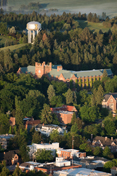No, That’s Not a Giant Hornet: U of I Entomologists Educate Community After False Sightings
September 28, 2022
MOSCOW, Idaho — A harmless, native insect known as the cicada killer wasp is being mistaken throughout Idaho as an international invader with a menacing reputation.
University of Idaho Extension Entomologists Jason Thomas, of Minidoka County, and Brad Stokes, of Elmore County, recently responded to several purported sightings of northern giant hornets – formerly referred to as murder hornets – known for their painful sting and decimation of honeybee colonies.
The entomologists run the Idaho Insect Identification website helping farmers, ranchers and Idaho’s general public correctly identify insects, arachnids and other arthropods.
In most user-submitted reports for bug identification investigated by Thomas and Stokes, people confused the giant hornet with the cicada killer wasp – a large, solitary insect that resembles the giant hornet but is docile and beneficial, helping control pests and pollinate flowers. Cicada killer wasps have black abdomens with yellow bands and orange-tinted wings. They also have smaller heads and torsos than northern giant hornets.
The insect identification website has prevented many users from unnecessarily applying pesticide against harmless or beneficial insects, such as cicada killer wasp, Stokes said.
“We’re saving the person financially, as well as Idaho’s environment and ecosystems from unwarranted pesticide applications,” Stokes said.
Northern giant hornets, which attack bee colonies, have not been found in Idaho to date. The insects — the world’s largest hornet species, discernable by their large jaws and dark, prominent eyes — made national headlines in May 2020 when they surfaced in northwest Washington. They have also been found in southwest Canada.
“Cicada killer wasps are bigger than the standard wasp and make a loud noise when flying around,” Thomas said. “People are afraid they’re going to get stung, but they’re not highly aggressive.”
Lately, the cicada killer wasp has been by far the most common insect submitted for identification. Stokes was also inundated with questions about cicada killer wasps mistaken for giant hornets at the recent Elmore County Fair. In response, he posted about the beneficial insect on the county’s 4-H Facebook page: “Their value in the ecosystem far outweighs the potential sting hazard.”
Female cicada killer wasps hunt cicadas, which they paralyze with their sting and bring back to their subterranean nests. They lay their eggs in cicadas to provide a food source for offspring. Idaho has species of cicadas that hatch annually, but the wasps also feed on stink bugs, grasshoppers and other large insects.
Northern giant hornets prefer cool, forested environments. They grow to about 2 inches long, roughly three-quarters of an inch bigger than cicada killer wasps. Northern giant hornets have gold bands and are most easily distinguished by their oversized heads and mandibles, which they use to attack and crush honeybees before feeding on bee larvae and pupae.
Learn more about the northern giant hornet and several look-alike species.
—
Media Contact
John O’Connell
Assistant Director of Communications, College of Agricultural and Life Sciences
208-530-5959
joconnell@uidaho.edu
Jason Thomas
University of Idaho Extension entomologist, Minidoka County
208-436-7184
jasont@uidaho.edu
Brad Stokes
University of Idaho Extension entomologist, Elmore County
208-587-2130
bstokes@uidaho.edu

About the University of Idaho
The University of Idaho, home of the Vandals, is Idaho’s land-grant, national research university. From its residential campus in Moscow, U of I serves the state of Idaho through educational centers in Boise, Coeur d’Alene and Idaho Falls, nine research and Extension centers, plus Extension offices in 42 counties. Home to more than 12,000 students statewide, U of I is a leader in student-centered learning and excels at interdisciplinary research, service to businesses and communities, and in advancing diversity, citizenship and global outreach. U of I competes in the Big Sky and Western Athletic conferences. Learn more at uidaho.edu.






